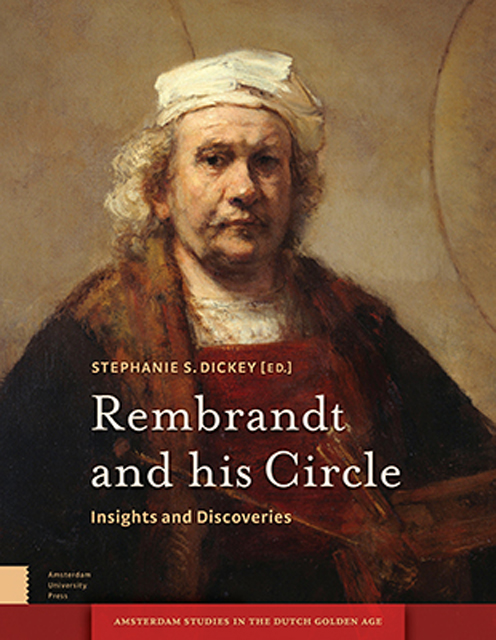Book contents
- Frontmatter
- Dedication
- Contents
- Acknowledgements
- Introduction
- 1 Rembrandt and Frans Hals Painting in the Workshop of Hendrick Uylenburgh
- 2 Rembrandt and the Germanic Style
- 3 Rembrandt and the Humanist Ideal of the Universal Painter
- 4 Curiosity and Desire: Rembrandt’s Collection as Historiographic Barometer
- 5 Painted Landscapes by Lievens and Rembrandt : The View from Seventeenth-Century Amsterdam Collections
- 6 Jan Lievens in Antwerp: Three Rediscovered Works
- 7 Gerrit Dou as a Pupil of Rembrandt
- 8 A New Painting by Jan van Noordt in Budapest
- 9 Rembrandt’s First Nude? The Recent Analysis of Susanna and the Elders from Rembrandt’s Workshop
- 10 Rembrandt’s Head of Christ: Some Technical Observations concerning Matters of Style
- 11 A Rediscovered Head of John the Baptist on a Platter from Rembrandt’s Studio
- 12 Rembrandt’s One Guilder Print: Value and Invention in ‘the most beautiful [print] that ever came from the burin of this Master’
- 13 Rembrandt, Ferdinand Bol, and Tobit: The Emergence of a Pathosträger
- 14 Biblical Iconography in the Graphic Work of Rembrandt’s Circle
- 15 Jan van Vliet and Rembrandt van Rijn: Their Collaboration Reassessed
- 16 Printmaking among Artists of the Rembrandt School
- 17 Chain Line Pattern Matching and Rembrandt’s Prints
- List of Illustrations
- Bibliography
- Index Nominum
3 - Rembrandt and the Humanist Ideal of the Universal Painter
Published online by Cambridge University Press: 21 January 2023
- Frontmatter
- Dedication
- Contents
- Acknowledgements
- Introduction
- 1 Rembrandt and Frans Hals Painting in the Workshop of Hendrick Uylenburgh
- 2 Rembrandt and the Germanic Style
- 3 Rembrandt and the Humanist Ideal of the Universal Painter
- 4 Curiosity and Desire: Rembrandt’s Collection as Historiographic Barometer
- 5 Painted Landscapes by Lievens and Rembrandt : The View from Seventeenth-Century Amsterdam Collections
- 6 Jan Lievens in Antwerp: Three Rediscovered Works
- 7 Gerrit Dou as a Pupil of Rembrandt
- 8 A New Painting by Jan van Noordt in Budapest
- 9 Rembrandt’s First Nude? The Recent Analysis of Susanna and the Elders from Rembrandt’s Workshop
- 10 Rembrandt’s Head of Christ: Some Technical Observations concerning Matters of Style
- 11 A Rediscovered Head of John the Baptist on a Platter from Rembrandt’s Studio
- 12 Rembrandt’s One Guilder Print: Value and Invention in ‘the most beautiful [print] that ever came from the burin of this Master’
- 13 Rembrandt, Ferdinand Bol, and Tobit: The Emergence of a Pathosträger
- 14 Biblical Iconography in the Graphic Work of Rembrandt’s Circle
- 15 Jan van Vliet and Rembrandt van Rijn: Their Collaboration Reassessed
- 16 Printmaking among Artists of the Rembrandt School
- 17 Chain Line Pattern Matching and Rembrandt’s Prints
- List of Illustrations
- Bibliography
- Index Nominum
Summary
Abstract
In a milieu where many artists became specialists, Rembrandt's oeuvre shows an amazing diversity in subject, medium, technique, and style. This uncommon ambition may be understood in the context of the humanist ideal of the pictor absolutus (Alberti), pittore universale (Leonardo, Vasari), or ghemeensaeme schilder (Van Mander). Rembrandt was probably inspired as a youth by his sponsor Constantijn Huygens, who fervently promoted this ideal. Later, his pupil Samuel van Hoogstraten places it at the center of his own theory of painting. This ideal also fits into the humanist fascination with universal knowledge of the world, realized in encyclopaedic collections and symbolised by the pairs of globes figuring in countless painted interiors. Rembrandt's Self-Portrait with Two Circles (London, Kenwood House) can be interpreted as a pictorial formulation of this ideal.
Keywords: Rembrandt van Rijn, humanist art theory, universal painter, encyclopaedic collection, Constantijn Huygens
In many respects Rembrandt was an unusual figure in the art world of his time. One of the most striking features is the extraordinary diversity of his oeuvre. Whereas most of his Dutch colleagues chose to specialize in one or perhaps two genres, Rembrandt's artistic range of action seems to have widened year after year. This applies to both the chosen subjects and the different techniques: in painting and etching as well as in drawing he created a more or less independent oeuvre of its own, each of which offers a surprising degree of thematic variety. Moreover, throughout his life he continued to experiment with different stylistic and technical ways of expression within the different media.
In his choice of subjects, too, we see a gradual extension. During his Leiden years Rembrandt concentrates on history painting, but after his move to Amsterdam he develops portraiture and, a few years later, also landscape as new fields of action. Both portrait and landscape seem to grow, as it were, out of history painting into separate and richly varied specialties in their own right. Within the portrait genre Rembrandt explores all the available options and applications, from the loosely sketched study and the tronie (character head) to the portrait historié and the private commission, and from the official and the group portrait to the self-portrait as a completely separate field of artistic research with versions in all shapes and sizes.
- Type
- Chapter
- Information
- Rembrandt and his CircleInsights and Discoveries, pp. 67 - 98Publisher: Amsterdam University PressPrint publication year: 2017



